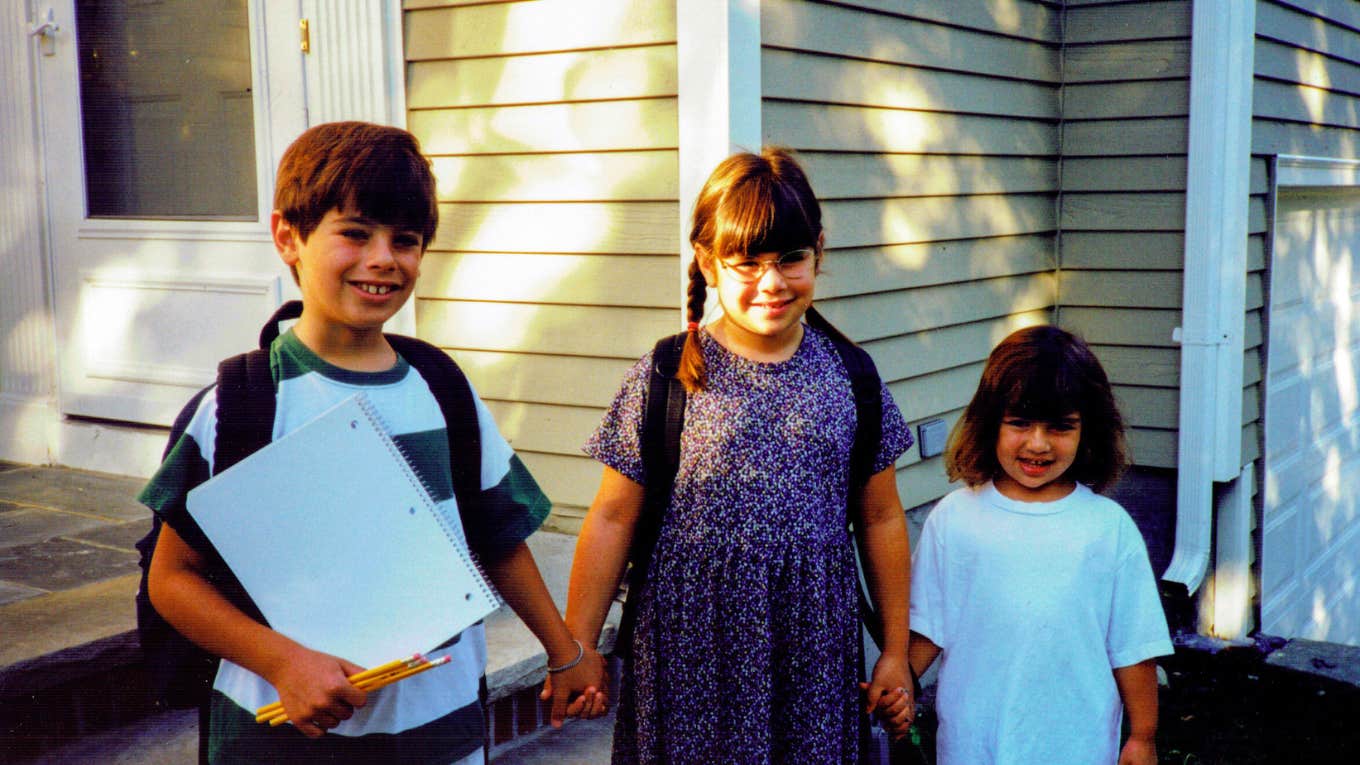12 Things Millennials Were Taught In School That Turned Out To Be Completely Useless
As the very name of their generation implies, millennials were born on the cusp of lightning fast transformations in our society.
 Cabeca de Marmore / Shutterstock
Cabeca de Marmore / Shutterstock Born between 1981 and 1996, millennials were named as such because they came of age during the new millennium. While the majority were born into a world without Internet access, they did experience a sharp uptick in technology use that shaped their understanding of their own identities and the ways they relate to people around them.
Millennials stood on a unique line of history, as they grew up alongside the World Wide Web and before the start of social media. Their education involved a mix of old and new technologies which have now evolved so quickly that there are many things millennials were taught in school that turned out to be completely useless now.
Here are 12 things millennials were taught in school that turned out to be completely useless
1. How to use an encyclopedia
 polinaloves | Shutterstock
polinaloves | Shutterstock
Millennials were taught to rely on physical encyclopedias as their main source of information. Every time they had a research paper, millennials went to the library and stood in front of the row of heavy, leather-bound books that always seemed just out of reach. Once they figured out which edition they needed, they spent hours poring over the pages and handwriting notes, along with citation information for their bibliographies.
While millennials were taught the extensive process of using physical encyclopedias for research, it turned out to be completely useless, since the rise of the Internet made all the world’s information accessible with a few keystrokes. Encyclopedias are now fairly obsolete, and the information within them is totally outdated, making them a relic of millennial classrooms that are no longer of any use.
2. How to write in cursive
 fizkes | Shutterstock
fizkes | Shutterstock
Millennials were taught cursive handwriting in schools, which it turned out to be completely useless as digital communication overtook the written word. The hours millennials spent tracing cursive letters is time they can never get back. Outside of writing their signatures, cursive doesn’t have a stronghold on the modern workplace the way millennial-era teachers said it would.
While many teachers believe that the lack of cursive lessons in today’s classrooms is a detriment to their students’ education, cursive was removed from the “Common Core” standards in 2010 as focus was switched to keyboarding lessons. There are 21 states that still require cursive to be taught, as many researchers believe the skill improves retention and comprehension of information while engaging the brain on a deeper level.
In 2022, the National Education Association asked educators across the U.S. whether they thought cursive was necessary or entirely outdated. “Kids can barely print,” said one teacher. “I love cursive, but we need to get the basic concepts of writing down first, such as capitals, punctuation, writing in a straight line. I'm seeing poor writing skills in fourth through eighth grade.”
“It's not about what will be ‘useful’ for us in later life,” another teacher replied. “Writing in cursive aids in brain development and primes the brain for increased learning.”
The usefulness of cursive ultimately depends on what profession someone goes into. A scientist might not have much use for it, but a historian absolutely needs to know cursive, as many historical documents, including the Declaration of Independence and the Bill of Rights, are written in cursive.
While the debate over cursive rages on in schools, millennials know that writing in cursive didn’t end up being the vital workplace skill they were told it would be.
3. How to do long division by hand
 fizkes | Shutterstock
fizkes | Shutterstock
Another thing millennials were taught in school that turned out to be completely useless was doing long division by hand. Picture a math class, circa 1999: heads adorned with butterfly clips and frosted tips bent over the week’s pop quiz, which demanded that everyone “show their work” — or else. This command meant going step by step through math problems, including long division, which millennials spent countless hours learning.
Millennials were told by well-meaning teachers that learning long division was important in the long run, because they wouldn’t always have a calculator in their pockets. Fast forward 25 years, and as it turns out, we do all have calculators in our pockets, thanks to Steve Job’s visionary invention.
While millennials spent their sweet childhood years agonizing over doing complex math problems by hand, that skill turned out to be completely useless.
4. The concept that college is the only path to success
 fizkes | Shutterstock
fizkes | Shutterstock
Millennials were taught that college was the only path for success, an idea that turned out to be completely useless. Millennials were a highly educated generation, which also means they were saddled with student loan debt in a serious way. According to a 2014 Pew Research Center survey, 34% of millennials have bachelor’s degrees, yet have also faced more intense economic hardships than Gen X and boomers before them.
The Pew Research Center reported that millennials face higher levels of student debt, unemployment and poverty, and lower levels of wealth and personal income than the preceding generations did at the same point in their lives. Because they were told that college was the only way they could be professionally successful, most millennials swallowed that particular pill. They went into major debt instead of getting vocational training or walking less traditional career paths.
While going to college has its benefits, it’s a lie to say that it’s the only way someone can be successful. Young people’s outlook on college has now changed significantly, with 47% of US adults now saying college is worthwhile only without taking out loans, 29% saying it’s not worth it at all, and only 22% saying it’s worth it, even with loans. Only 25% believe that they need a degree to guarantee a job, while 35% believe getting a degree is somewhat important. The 40% who believe a college degree isn’t necessary to get a well-paying job might be absolutely right.
More and more Gen Zers are choosing trade school and blue collar jobs over a traditional college education, showing that they’re preparing for the reality of their economic future in a way millennials never did.
5. Using a card catalog
 sirtravelalot | Shutterstock
sirtravelalot | Shutterstock
Another thing millennials were taught in school that turned out to be completely useless was how to find books in a library using a card catalog. In the U.S., the invention of the physical card catalog is credited to Ezra Abbott, the assistant librarian at Harvard College, in 1861. By 1877, the American Library Association announced the standardization of the card catalog. This system held strong until 2015, when the last library catalog card was printed.
Millennials spent hours learning this classification system, only for it to disappear from schools with the rise of the Internet. Book information at libraries and beyond is now stored online, which makes knowing how to interpret the Dewey Decimal System and look up books via card catalog completely useless.
6. Square dancing
 PeopleImages.com - Yuri A. | Shutterstock
PeopleImages.com - Yuri A. | Shutterstock
Millennials were taught square dancing in gym class, a skill that turned out to be completely useless for their future success. The root of learning how to swing your partner round and round in school goes all the way back to the 1920s.
Henry Ford of Ford Motors believed that jazz music and dancing was the cause of all moral decay in America. Ford’s belief that jazz was corrupting young minds combined with his deeply antisemitic and historically inaccurate belief that jazz was part of a Jewish plot to take over the world.
In 1926, Ford published an instruction manual for aspiring square dance instructors and required his employees to attend square dancing events. He poured his money and influence into lobbying for square dancing to become part of America’s physical education curriculum in order to teach kids “social training, courtesy, good citizenship, along with rhythm.” By 1928, almost half of schools across the country did just that.
Despite Ford’s attempts at indoctrinating kids into white supremacist culture through partner dancing, he overlooked the fact that the American square dancing tradition was built alongside Black people. Ford held tight to his white-washed version of culture and history, and 70 years later, millennial kids played out his vision of Americana in their sweaty school gyms.
7. How to clean a chalkboard
 fizkes | Shutterstock
fizkes | Shutterstock
Millennials were taught all the skills needed to expertly clean a chalkboard and its various accouterments, only for chalkboards to be phased out and replaced by whiteboards first, then by digital screens. Millennial kids dutifully wiped yellow streaks of chalk off the blackboard, struggling not to wince at the horrible screeching sound that inevitably occurred anytime anyone touched a chalkboard. They learned to step into the hallway and clap erasers together, stifling their cough as clouds of chalk dust rose.
If part of being seen as a good student was following the teacher’s directions, millennials had their chalkboard cleaning techniques on lock. Yet chalkboards became a thing of the past, and so did their replacement, whiteboards, and now, millennials’ chalk management skills are completely useless.
8. How to play the recorder
 Ground Picture | Shutterstock
Ground Picture | Shutterstock
Another thing millennials were taught in school that turned out to be completely useless is how to play the recorder. There’s no denying that a musical education is a crucial part of forming young minds. Learning to play an instrument teaches kids a different, more expansive way to use their brains, while fostering creativity and an appreciation for the arts. While the recorder may have been the simplest entry point to playing music for millennial kids, those kids became adults whose recorder skills start and stop with “Hot Cross Buns.
While some millennials took their recorder concerts seriously and showed up with their A-game, others remain haunted by the syncopated screeching sounds to this day. At its best, learning to play the recorder gave millennials a jumping off point to learn other instruments, and at worst, was a skill that turned out to be totally useless.
9. How to read paper maps
 fizkes | Shutterstock
fizkes | Shutterstock
Reading paper maps is something millennials were taught in school that turned out to be totally useless. Geography teachers across the nation watched as their students struggled to unfold and refold paper maps, intoning the importance of knowing cardinal signals and navigation skills. Millennials learned that some squiggly lines meant rivers, while others meant canyons, and others still were just plain roads. When millennials got their drivers licenses, many left the DMV armed with paper maps that their dad insisted they keep in the glove compartment of their cars, just in case.
The use of paper maps decreased significantly by the time millennials hit adulthood, making their map-reading skills completely useless. The rise in use of GPS navigation systems and apps like GoogleMaps, which basically hold your hand and walk you from one location to the next, meant that millennials didn’t have to pull out their paper maps, making that particular geography lesson completely useless.
10. Nutrition based on the original food pyramid
 Ground Picture | Shutterstock
Ground Picture | Shutterstock
The version of nutrition that millennials were taught in schools turned out to be completely useless and majorly lacking in actual nutritional value. In 1992, the USDA formalized a version of the food pyramid that’s seared into millennials’ collective consciousness: bread, pasta, and cereal at the base, fruits and vegetables next, followed by protein and dairy, with fats, oils, and sweets at the top to be “used sparingly.”
The food pyramid was steeped in a high-carb, low-fat diet mindset, which, as it turns out, isn’t that great for people. The '90s-era food pyramid neglected to point out that there is such a thing as good fats, and that eating highly-processed food can lead to negative health outcomes.
Along with learning this nutritionally imbalanced food pyramid, millennials were around in 1981, when the Reagan administration declared ketchup as a vegetable in an attempt to cut $1.5 billion from children’s nutrition funding. The requirements for school lunch programs were eroded in a way to allow for ketchup to be designated as a vegetable, which meant the USDA could eliminate one of the two required vegetables to meet minimum food and nutrition standards.
At the time, millennials were young enough to celebrate the idea of stuffing their faces with Fruit Loops and ketchup, but it turns out that the food pyramid they learned was completely useless.
11. The importance of neat penmanship
 Ground Picture | Shutterstock
Ground Picture | Shutterstock
Millennials were taught that the neatness of their handwriting could make or break them in the professional world, which is information that turned out not to be true at all. Millennials were graded not only on how well they presented information they’d learned in their assignments, but also on the quality of their handwriting itself.
Fear was struck into the heart of every student who handed in a scrawled-out, sloppily-lettered paper, as their teachers proclaimed they’d never be successful because their penmanship was so deplorable. By the time millennials got to college and entered the workforce, the majority of communication had shifted over to digital, meaning that their handwriting had, in fact, no importance whatsoever for their professional advancement .
While there are specific jobs where handwriting is important, like being a teacher, overall, handwriting neatness is something millennials were taught in school that turned out to be completely useless now that pretty much everyone works on a computer.
12. Standardized testing tricks
 SistersStock | Shutterstock
SistersStock | Shutterstock
Millennials were taught standardized testing techniques that turned out to be completely useless outside of the tests themselves. Having a high IQ and being a good test taker are two very different things. There are highly intelligent people who are terrible at taking tests and people with low IQs who have what seems like magical test-taking abilities.
A major aspect of millennials’ education was learning how to take standardized tests, which isn’t something that would actually help them move ahead in their lives after school ended. Test-taking skills don’t automatically translate into critical thinking skills. All they teach is how to take a very specific test, which turned out to be completely useless over the course of millennials’ lifetimes.
Alexandra Blogier, MFA, is a staff writer who covers psychology, social issues, relationships, self-help topics, and human interest stories.

